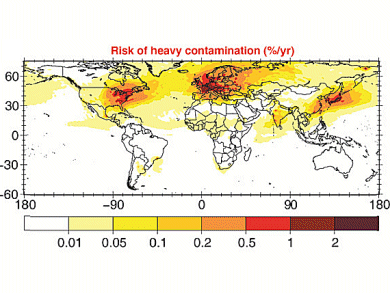Catastrophic nuclear accidents such as the core meltdowns in Chernobyl and Fukushima are more likely to happen than previously assumed. Scientists around Johannes Lelieveld, Max Planck Institute for Chemistry (MPI), Mainz, Germany, have calculated that such events may occur once every 10 to 20 years.
To determine the likelihood of a nuclear meltdown, the researchers divided the operating hours (14,500 years) of all civilian nuclear reactors in the world, from the commissioning of the first up to the present, by the number of reactor meltdowns (4) that have actually occurred. This translates into one major accident, being defined according to the International Nuclear Event Scale (INES), every 3,625 years. Even if this result is conservatively rounded to one major accident every 5,000 reactor years, the risk is 200 times higher than the estimate for catastrophic, non-contained core meltdowns made by the U.S. Nuclear Regulatory Commission in 1990.
The computer simulations revealed that in the event of a major accident, on average, only 8 % of the 137Cs particles are expected to deposit within an area of 50 km around the nuclear accident site. Around 50 % would be deposited outside a radius of 1,000 km, and around 25 % would spread even further than 2,000 km.
Western Europe, where the density of reactors is particularly high, the contamination by more than 40 kilobecquerels of 137Cs/m2 is expected to occur once in about every 50 years. According to the International Atomic Energy Agency, an area is defined as being contaminated with radiation from this amount onwards.
Citizens in the densely populated southwestern part of Germany run the worldwide highest risk of radioactive contamination, associated with the numerous nuclear power plants situated near the borders between France, Belgium, and Germany, and the dominant westerly wind direction. If a single nuclear meltdown were to occur in Western Europe, around 28 million people on average would be affected by contamination of more than 40 kilobecquerels/m2. A major nuclear accident in southern Asia would affect around 34 million people, while in the eastern USA and in East Asia this would be 14 to 21 million people.
In view of their findings, the researchers call for an in-depth analysis and reassessment of the risks associated with nuclear power plants.
Image: Global risk of radioactive contamination. The map shows the annual probability in
percent of radioactive contamination. © Daniel Kunkel, MPI for Chemistry, 2011
- Global risk of radioactive fallout after nuclear reactor accidents,
Jos Lelieveld, Daniel Kunkel, Mark G. Lawrence,
Atmos. Chem. Phys. 2012, 12, 4245–4258.
DOI: 10.5194/acp-12-4245-2012


